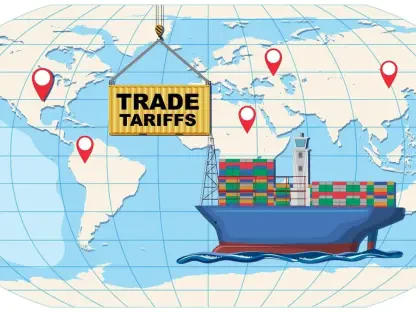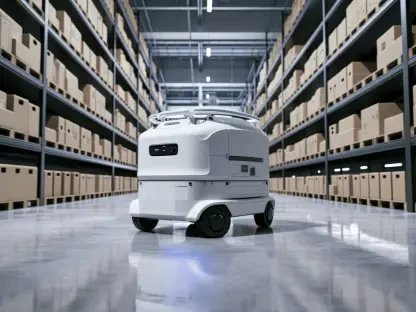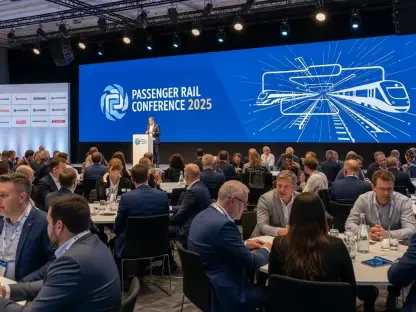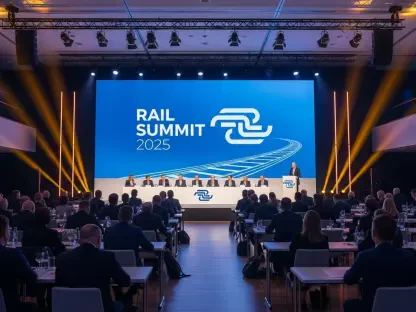In an era where online shopping dominates consumer behavior, the retail sector faces unprecedented pressure to deliver goods with lightning speed and unwavering reliability. Imagine a customer ordering a new laptop on a Friday, expecting it to arrive by Sunday for a critical work presentation—such scenarios are no longer outliers but benchmarks of modern retail success. With e-commerce sales continuing to soar, the ability to meet these expectations can make or break a retailer’s reputation. This report dives into a transformative partnership between Best Buy, a leading electronics retailer, and FedEx, a logistics giant, exploring how this collaboration aims to redefine delivery efficiency in a hyper-competitive market. The focus lies on the strategic moves and innovative solutions that could set a new standard for customer satisfaction in retail logistics.
Understanding the Retail Delivery Landscape
The retail delivery sector is undergoing a seismic shift, driven by the explosive growth of e-commerce and heightened consumer demand for rapid shipping. Speed is no longer a luxury but a necessity, as customers increasingly expect same-day or next-day delivery as a standard offering. Reliability, too, plays a critical role, with missed deliveries or delayed shipments often leading to lost trust and revenue. Major retailers are racing to optimize their supply chains to stay ahead, making logistics a cornerstone of competitive advantage in this digital age.
Key players like FedEx and UPS dominate the parcel delivery space, handling millions of packages daily across vast networks. Alongside them, emerging services such as OnTrac and Shipt are carving out niches by offering localized, flexible solutions. Technology is reshaping this landscape, with innovations like real-time tracking, automated sorting systems, and data analytics enabling companies to streamline operations. These advancements allow retailers to predict demand, optimize routes, and provide transparency, all of which are vital in meeting the modern shopper’s expectations.
The stakes are higher than ever as peak shopping seasons, such as the holidays, test the limits of logistics infrastructure. Retailers must balance cost efficiency with scalability to handle sudden surges in order volume. As consumer behavior continues to evolve toward instant gratification, the pressure mounts on companies to forge partnerships and adopt tools that can deliver both speed and precision in an increasingly crowded market.
Strategic Partnership Between FedEx and Best Buy
Key Features of the Collaboration
Best Buy’s decision to name FedEx as its primary national parcel carrier marks a pivotal step in enhancing its delivery capabilities. A standout feature of this partnership is FedEx’s Sunday delivery service, which covers nearly two-thirds of the U.S. population. This offering allows Best Buy to expedite shipments over weekends, a capability not universally matched by competitors, ensuring customers receive their orders even during non-traditional delivery windows.
Another significant aspect is the integration of FedEx’s real-time tracking data into Best Buy’s customer communication systems. This enhancement provides shoppers with up-to-the-minute updates on their orders, fostering transparency and reducing uncertainty. Such features directly address the growing consumer demand for visibility into the delivery process, setting Best Buy apart in a market where clarity is as valued as speed.
The collaboration also emphasizes scalability, with FedEx committing to handle a substantial volume of packages weekly for major clients like Best Buy. This capacity ensures that the retailer can meet demand spikes without compromising on delivery timelines. By aligning with FedEx’s robust network, Best Buy positions itself to offer a seamless shopping experience that prioritizes both efficiency and reliability.
Impact on Delivery Performance and Customer Experience
FedEx’s advanced logistics infrastructure is expected to significantly improve Best Buy’s delivery performance by minimizing delays and enhancing order accuracy. The integration of real-time tracking is projected to reduce support calls from frustrated customers seeking updates, as they can now access detailed information directly. This shift not only streamlines customer service operations but also lowers the likelihood of order cancellations due to uncertainty.
Additionally, the partnership is anticipated to decrease reshipping costs for Best Buy, as fewer packages are likely to be lost or misdelivered with FedEx’s precise tracking and expansive network. Early data from the implementation suggests a potential uptick in on-time delivery rates, which could translate into higher customer satisfaction scores. These improvements are crucial for retaining loyalty in a sector where a single negative experience can drive shoppers to competitors.
Looking ahead, projections indicate that as the collaboration matures over the next few years, Best Buy could see a measurable boost in operational efficiency. With FedEx handling the bulk of last-mile delivery, the retailer can focus on other aspects of its business, such as product innovation and in-store experiences. This synergy promises to create a ripple effect, enhancing the overall perception of Best Buy as a customer-centric brand.
Challenges in Optimizing Delivery Efficiency
Scaling FedEx’s role as Best Buy’s primary carrier is not without hurdles, particularly in regions where coverage may be limited or inconsistent. While FedEx boasts an extensive network, certain rural or less accessible areas might still pose logistical challenges, potentially leading to disparities in delivery times. Addressing these gaps will require strategic planning and possibly supplementary partnerships to ensure uniform service quality across all markets.
Integration complexities also loom as a potential obstacle, as aligning Best Buy’s internal systems with FedEx’s technology demands significant coordination. Data synchronization and workflow adjustments must be seamless to avoid disruptions in order processing or customer communications. Both companies will need to invest in robust IT solutions and training to mitigate risks during this transition phase.
Broader industry challenges further complicate the landscape, including rising logistics costs and persistent labor shortages that strain delivery operations. Peak seasons amplify these issues, with high demand often exposing weaknesses in capacity and reliability. To counter these, Best Buy and FedEx might explore strategies such as dynamic pricing models, temporary staffing surges, and predictive analytics to better prepare for volume spikes and maintain service standards.
Regulatory and Operational Considerations
The parcel delivery industry operates under a stringent regulatory framework that both FedEx and Best Buy must navigate carefully. Compliance with federal and state shipping standards is non-negotiable, covering everything from package handling to delivery timelines. Adhering to these rules ensures that operations remain lawful while protecting consumers from potential mishaps or delays in service.
Data privacy laws add another layer of complexity, especially concerning real-time tracking information shared with customers. Protecting personal data against breaches or misuse is paramount, as any lapse could damage trust and invite legal repercussions. Both companies must prioritize secure systems and transparent policies to safeguard customer information while leveraging tracking for operational benefits.
Operationally, aligning their processes to meet regulatory demands without sacrificing efficiency requires meticulous planning. This includes regular audits, staff training on compliance protocols, and investment in technology that supports secure data handling. By maintaining a proactive stance on these considerations, FedEx and Best Buy can uphold high service standards while minimizing the risk of regulatory violations.
Future Outlook for Retail Delivery Innovation
The partnership between FedEx and Best Buy could serve as a blueprint for future trends in retail logistics, particularly with the adoption of Sunday delivery as a mainstream offering. As more retailers recognize the value of weekend shipping in meeting consumer needs, competitors may follow suit, potentially reshaping industry norms. This shift could drive broader acceptance of non-traditional delivery schedules over the coming years.
Advanced tracking technologies, as showcased in this collaboration, are likely to become a staple in retail logistics, pushing the envelope for transparency. Beyond current innovations, emerging disruptors like drone delivery and autonomous vehicles hold the potential to further revolutionize the sector. While still in early stages, these technologies could drastically cut delivery times and costs if regulatory and technical barriers are overcome.
Global supply chain dynamics and shifting consumer expectations will continue to influence the direction of retail delivery. Issues such as geopolitical tensions or raw material shortages might disrupt logistics, necessitating agile responses from partnerships like this one. Staying ahead will require continuous investment in innovation and flexibility to adapt to both technological advancements and market demands.
Conclusion and Strategic Implications
Reflecting on the journey of this partnership, the alliance between FedEx and Best Buy emerged as a game-changer in tackling the complexities of retail delivery. The collaboration harnessed FedEx’s strengths in Sunday shipping and real-time tracking to elevate Best Buy’s operational efficiency, setting a precedent for how strategic carrier relationships could transform customer experiences. Cost savings and improved transparency stood out as tangible outcomes that fortified Best Buy’s market position.
Moving forward, actionable steps should center on deepening technological integration to further streamline logistics processes. Exploring pilot programs for emerging delivery methods, such as drones, could position both companies as pioneers in the next wave of innovation. Additionally, maintaining a flexible mix of delivery partners will be crucial to address regional disparities and peak-season pressures effectively.
A key consideration for the future lies in anticipating shifts in consumer behavior and global supply dynamics. Best Buy and FedEx should prioritize building adaptive strategies, such as leveraging predictive analytics for demand forecasting, to stay resilient amid uncertainties. By committing to continuous improvement and embracing cutting-edge solutions, this partnership can sustain its competitive edge and inspire industry-wide advancements in retail logistics.









